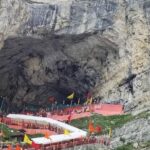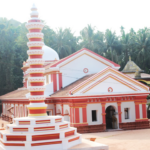The Nageshwar Jyotirlinga is one of the twelve Jyotirlingas of Lord Shiva and is located in Dwarka, in the state of Gujarat, India. The temple holds immense spiritual importance and is considered a powerful center of devotion to Lord Shiva. The Nageshwar Temple is located on the route between Dwarka and Bet Dwarka, making it a significant pilgrimage site in the region.
Mythological Significance:
The Nageshwar Jyotirlinga is associated with several legends, all emphasizing Lord Shiva’s role as a protector and destroyer of evil.
- The Legend of Supriya:
- According to ancient Hindu scriptures, there was a demon named Daruka, who, along with his wife Daruki, terrorized the people. Daruka had received a boon from Goddess Parvati that allowed him to create a forest named Darukavana, where he ruled over other demons.
- A devotee of Lord Shiva, Supriya, was captured by Daruka and imprisoned along with many others. While in captivity, Supriya chanted the sacred mantra “Om Namah Shivaya” and prayed to Lord Shiva for protection.
- Pleased with Supriya’s devotion, Lord Shiva appeared and vanquished Daruka and his demons. Shiva also set the captives free and promised to protect those who worshipped him with sincerity. As a result, Lord Shiva manifested as the Nageshwar Jyotirlinga at that location.
- The Story of Nageshwar and Daarukavana:
- Another version of the legend mentions that the Nageshwar Jyotirlinga was located in the Darukavana forest, which was sacred to Lord Shiva. The forest was home to many sages and devotees who worshipped Lord Shiva with great reverence. However, the demons began disturbing the peace in the forest.
- Lord Shiva appeared to protect his devotees and established himself as the Nageshwar Jyotirlinga, symbolizing his role as the protector of the innocent and destroyer of evil.
- Association with Lord Krishna:
- Some legends link the Nageshwar Jyotirlinga to Lord Krishna, who is believed to have worshipped Lord Shiva at this spot. Krishna is said to have installed the Jyotirlinga in the Dwarka region to ensure the safety and prosperity of his kingdom.
Historical and Spiritual Importance:
- The Nageshwar Jyotirlinga is significant as it represents the protective and benevolent aspect of Lord Shiva. Devotees believe that worshipping the Jyotirlinga can protect them from evil forces, and it is also associated with overcoming negativity, fear, and suffering.
- Nageshwar is also one of the few temples associated with the worship of Shakti, as Daruka (the demoness in the myth) was blessed by Goddess Parvati. Thus, the temple represents a unique blend of Shiva and Shakti worship.
Architectural Significance:
- The Nageshwar Temple has a modern and grand structure, featuring a large Shiva Lingam in its sanctum. The architecture is simple yet elegant, drawing large numbers of pilgrims.
- The temple also has a towering Shiva statue outside, which stands about 25 meters tall. This massive idol of Lord Shiva is one of the main attractions of the temple and is visible from a great distance, adding to the spiritual ambiance of the area.
- The temple complex is surrounded by greenery and offers a peaceful environment for devotees to meditate and perform their prayers.
Rituals and Festivals:
- Abhishekam: One of the key rituals at the Nageshwar Jyotirlinga is the Abhishekam ceremony, where the Shiva Lingam is bathed with milk, water, honey, and other sacred items. This ritual is performed to purify the deity and seek blessings from Lord Shiva.
- Maha Shivaratri: The temple celebrates Maha Shivaratri with great devotion. Thousands of devotees gather to offer their prayers, participate in special rituals, and observe fasts in honor of Lord Shiva. The temple remains open throughout the night for prayers and worship.
- Shravan Month: The holy month of Shravan (July–August) is an important time for pilgrims to visit the temple, as it is dedicated to Lord Shiva. Special pujas, offerings, and prayers are held throughout this month, with devotees making long journeys to seek the blessings of Nageshwar Mahadev.
- Daily Aarti: The temple holds daily aarti (prayer ceremonies) in the morning and evening, where devotees sing hymns and offer flowers and food to Lord Shiva. The Mangal Aarti (early morning prayer) is considered particularly auspicious.
Spiritual Beliefs:
- Devotees believe that worshipping the Nageshwar Jyotirlinga protects them from evil and negative forces. The temple is considered a place of healing, both spiritually and mentally, where devotees can find solace and peace.
- The Nageshwar Jyotirlinga is also associated with freedom from fear and anxiety. It is said that Lord Shiva blesses his devotees with courage, strength, and protection from harm.
- Offering prayers at the Nageshwar Temple is believed to help people overcome difficult circumstances and challenges in life. Devotees also visit the temple to seek relief from physical ailments and mental distress.
How to Reach:
- Nageshwar Temple is located about 18 km from Dwarka, one of the most important cities associated with Lord Krishna. The temple is easily accessible by road, and local buses and taxis are available for transport.
- The nearest railway station is in Dwarka, which is well connected to major cities like Ahmedabad, Rajkot, and Jamnagar. The nearest airport is in Jamnagar, around 137 km from the temple.
Conclusion:
The Nageshwar Jyotirlinga is not just a temple but a powerful symbol of Lord Shiva’s protective and compassionate nature. The temple’s connection to ancient legends, its serene location near Dwarka, and the belief that Lord Shiva resides here as the protector of devotees make it a revered pilgrimage site. Visiting the Nageshwar Temple is said to provide spiritual peace, protection from evil, and the blessings of Lord Shiva, making it one of the most cherished destinations for followers of the Shaiva tradition.













